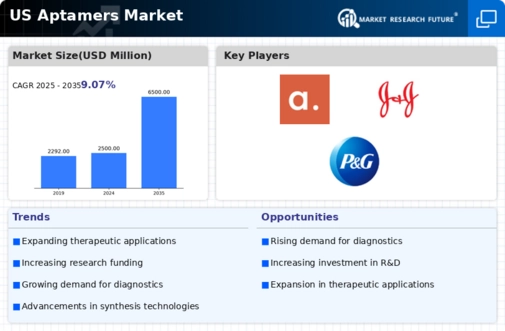Rising Prevalence of Chronic Diseases
The growing incidence of chronic diseases in the US is a critical driver for the aptamers market. Conditions such as cancer, diabetes, and cardiovascular diseases are on the rise, necessitating the development of effective diagnostic and therapeutic tools. Aptamers, known for their ability to bind specific biomolecules, are increasingly being explored for their potential in early disease detection and targeted treatment. According to recent statistics, chronic diseases account for approximately 70% of all deaths in the US, highlighting the urgent need for innovative healthcare solutions. The aptamers market is well-positioned to address these challenges, as the specificity and versatility of aptamers can lead to improved patient outcomes. Consequently, the demand for aptamer-based products is expected to increase, driving growth in the market and encouraging further research and development efforts.
Growing Interest in Point-of-Care Testing
The increasing demand for point-of-care testing (POCT) is emerging as a significant driver for the aptamers market. As healthcare providers seek rapid and accurate diagnostic solutions, aptamers are being recognized for their potential in POCT applications. The convenience and speed of these tests can lead to timely clinical decisions, which is particularly crucial in emergency settings. The US POCT market is projected to grow at a CAGR of over 10% through 2025, indicating a robust demand for innovative diagnostic tools. Aptamers, with their ability to provide specific and sensitive detection of biomarkers, are well-suited for integration into POCT devices. This trend suggests that the aptamers market could see substantial growth as more healthcare facilities adopt these technologies, ultimately improving patient care and outcomes.
Increasing Investment in Biopharmaceuticals
The aptamers market is experiencing a surge in investment, particularly within the biopharmaceutical sector. As companies seek innovative solutions for drug development, the demand for aptamers, which offer high specificity and affinity for targets, is likely to grow. In 2025, the biopharmaceutical market in the US is projected to reach approximately $500 billion, with a significant portion allocated to research and development. This influx of capital is expected to enhance the capabilities of the aptamers market, fostering advancements in therapeutic applications and diagnostics. Furthermore, the increasing focus on personalized medicine is driving the need for targeted therapies, which aptamers can effectively provide. As a result, the investment landscape appears favorable for the growth of the aptamers market, potentially leading to innovative products and solutions that address unmet medical needs.
Regulatory Support for Innovative Therapies
Regulatory frameworks in the US are increasingly supportive of innovative therapies, which is likely to benefit the aptamers market. The FDA has been actively working to streamline the approval processes for novel therapeutics, including those based on aptamer technology. This regulatory clarity encourages investment and research in the development of aptamer-based products. As the FDA continues to establish guidelines that facilitate the entry of new therapies into the market, companies are more inclined to explore the potential of aptamers for various applications. The favorable regulatory environment may lead to an increase in clinical trials and product launches, thereby expanding the market. Consequently, the aptamers market stands to gain from this supportive landscape, potentially accelerating the introduction of innovative solutions that address critical healthcare challenges.
Technological Advancements in Aptamer Production
Technological innovations in the production of aptamers are significantly influencing the aptamers market. Recent advancements in synthesis techniques, such as SELEX (Systematic Evolution of Ligands by Exponential Enrichment), have enhanced the efficiency and scalability of aptamer development. These improvements are likely to reduce production costs and time, making aptamer-based solutions more accessible to researchers and clinicians. As the market evolves, the introduction of automated platforms for aptamer synthesis is expected to streamline workflows and increase throughput. This technological progress may lead to a broader range of applications for aptamers, including diagnostics, therapeutics, and biosensors. The ability to produce high-quality aptamers at a lower cost could potentially expand the market reach, attracting new players and fostering competition within the aptamers market.














Leave a Comment